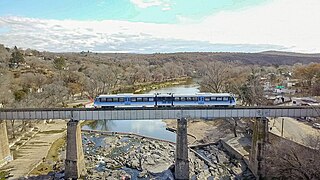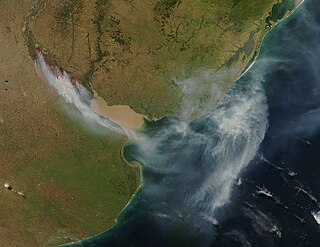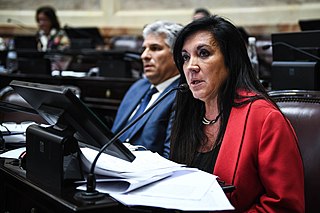The 2013 Argentine police revolts were a series of protests by provincial police demanding better pay and working conditions, which affected 21 of Argentina's 23 provinces.
The Great Fire of Valparaíso started on 12 April 2014 at 16:40 local time, in the hills of the city of Valparaíso, Chile. The wildfire destroyed at least 2,500 homes, leaving 11,000 people homeless. An additional 6,000 people were evacuated from the city, which was placed on red alert and declared a disaster zone. Fifteen people were confirmed killed and ten suffered serious injuries.

Tren de las Sierras is a 150.8 km (93.7 mi) regional rail line in Córdoba Province of Argentina. The line runs from Alta Córdoba to Capilla del Monte, being currently operated by state-owned company Trenes Argentinos Operaciones.

Fires in Galicia are caused by deforestation and brush clearing, the removal of indigenous fauna, and arsonists. The fires have been occurring since the mid-1990s. Fires in Galicia represent 50% of the area burned each year in Spain and 40% of all fires.

During August 2019, a number of forest fires broke out in the Canary Islands of Gran Canaria, Tenerife and Lanzarote. The fires on the island of Gran Canaria were the most severe, resulting in the loss of large areas of the island's forests and leading to the evacuation of thousands of residents from a number of towns and villages. The intense heat brought by a heat wave and the presence of strong winds, combined with the island's mountainous terrain, made extinguishing activities exceptionally difficult.

Fernet con coca, also known as fernando, its diminutive fernandito, or several other nicknames, is a long drink of Argentine origin consisting of the Italian amaro liqueur fernet and cola, served over ice. Although typically made with Fernet-Branca and Coca-Cola, several amaro brands have appeared in Argentina since its popularization, as well as ready-to-drink versions.

The 2020 Delta del Paraná wildfires is a series of wildfires that are burning across the Delta del Paraná in Argentina, affecting mainly the Entre Ríos and Santa Fe provinces, but also Buenos Aires, including major cities as Rosario.

The 2008 Delta del Paraná wildfires were a series of wildfires in the Delta del Paraná islands located mainly in Entre Ríos, Argentina. It was an unprecedented event that covered major cities as Buenos Aires and Rosario in smoke, affecting the health of millions of people. The first fires were detected on 13 April 2008, and lasted until April 25 – 26, when rain extinguished most of them. Buenos Aires was heavily affected between April 15 and April 20.
The 2020 COVID-19 pandemic in Argentina affected the human rights situation in the country.

We Do for Córdoba is a provincial political coalition in Córdoba Province, Argentina. It was formed in 2019 to support the gubernatorial candidacy of Juan Schiaretti by the Union for Córdoba – another political coalition consisting of, chiefly, the Justicialist Party – as well as the Socialist Party, the Intransigent Party and the GEN Party.
The Argentine Patagoniawildfires begun on Sunday March 7, 2021 when a focus of fire appeared at kilometer 21 of Provincial Route 6 of Río Negro Province, Argentina. Subsequently, the fire spread to Las Golondrinas, Lago Puelo, El Hoyo, El Maitén and Cholila in Chubut Province, following the 42nd parallel south. The fire would spread aided by the wind reaching populated areas where there have been reports of burned vehicles and the destruction of hundreds of houses. Servicio Nacional del Manejo del Fuego helped people evacuate the area. Various causes have been proposed for the fire, including the fall of a trees on electrical transmission cables, given that the fires follow the electrical wiring. Intentional fires have also been proposed as a cause. National minister of Ambiente y Desarrollo Sostenible, Juan Cabandié, called for an investigation through a criminal complaint about the causes of the fire. As of March 12, 2021, 11 people were missing.
Mario Pedro Pereyra was an Argentine radio host and businessman.

Laura Elena Rodríguez Machado is an Argentine politician who has been a National Deputy elected in Córdoba Province since 2021, and served as a National Senator for Córdoba from 2015 to 2021. A member of Republican Proposal (PRO), Rodríguez Machado previously served as a provincial legislator of Córdoba from 1991 to 1995 for the Union of the Democratic Centre (UCEDE). In the National Congress, she sits in the Juntos por el Cambio parliamentary inter-bloc. She is also the second vice president of PRO.

Carlos Alberto Caserio is an Argentine politician, who was a National Senator for Córdoba Province from 2015 to 2021 and a National Deputy from 2013 to 2015. A member of the Justicialist Party, Caserio formed part of the Union for Córdoba regional alliance from 1998 to 2019. In the Senate, he sat with the Frente de Todos parliamentary bloc from 2019 to 2021.

The 2022 Corrientes wildfires were a series of wildfires burning throughout the Corrientes Province in Argentina. It began in January of that year and continued to be active in many parts of the province, having consumed more than 800,000 hectares, which is equivalent to approximately ten percent of the province. The fire advanced over fields, mountains, wetlands and nature reserves, including the Iberá Wetlands, and has caused material damage estimated at between 25 and 40 billion pesos.

In mid-January 2022, the Southern Cone had a severe heat wave, which made the region for a while the hottest place on earth, with temperatures exceeding those of the Middle East. This extreme weather event was associated with the Atlantic anticyclone, a particularly intense La Niña phenomenon in the Pacific Ocean, and the regional effects of climate change.
Roberto José Carmona, known as The Human Hyena, is an Argentine thief, rapist and serial killer. Initially imprisoned for killing a teenage girl in 1986, Carmona proceeded to kill two inmates in separate incidents and culminating with the murder of a taxi driver during an escape attempt in 2022.

Starting on 30 January 2023, a series of wildfires began in the South American country of Chile. By early February, the fires had developed into a large outbreak of at least 406 individual fires, several dozen of which were classified as "red alert fires". The fires burned more than 430,000 hectares and resulted in the loss of 24 lives, prompting the government to declare a state of emergency in multiple regions of the country.

On 15 August 2023, a forest fire broke out on the island of Tenerife, in the Canary Islands of Spain. The fire, driven by the wind, heat, and low humidity levels, caused mass evacuations, widespread damage to the island's flora and fauna, as well as power and water supply cuts in some of the affected municipalities.
In August 2024, multiple wildfires started in Ecuador. What they resulted from is currently unknown.















